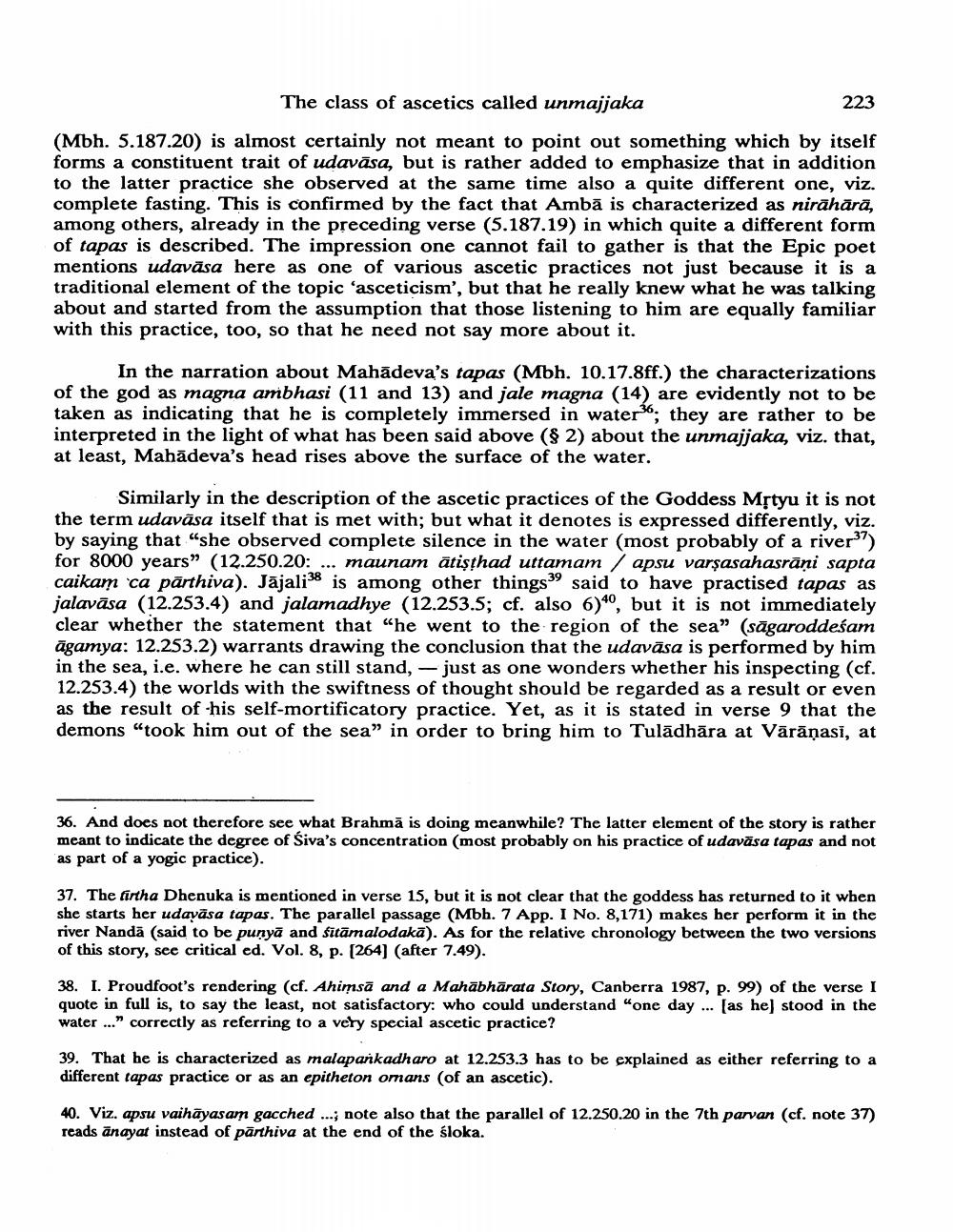Book Title: Note On Class Of Ascetics Called Unmajjaka Author(s): A Wezler Publisher: A Wezler View full book textPage 7
________________ The class of ascetics called unmajjaka 223 (Mbh. 5.187.20) is almost certainly not meant to point out something which by itself forms a constituent trait of udavāsa, but is rather added to emphasize that in addition to the latter practice she observed at the same time also a quite different one, viz. complete fasting. This is confirmed by the fact that Ambā is characterized as nirāhārā, among others, already in the preceding verse (5.187.19) in which quite a different form of tapas is described. The impression one cannot fail to gather is that the Epic poet mentions udavāsa here as one of various ascetic practices not just because it is a traditional element of the topic 'asceticism', but that he really knew what he was talking about and started from the assumption that those listening to him are equally familiar with this practice, too, so that he need not say more about it. In the narration about Mahādeva's tapas (Mbh. 10.17.8ff.) the characterizations of the god as magna ambhasi (11 and 13) and jale magna (14) are evidently not to be taken as indicating that he is completely immersed in water, they are rather to be interpreted in the light of what has been said above ($ 2) about the unmajjaka, viz. that, at least, Mahādeva's head rises above the surface of the water. Similarly in the description of the ascetic practices of the Goddess Mrtyu it is not the term udavāsa itself that is met with; but what it denotes is expressed differently, viz. by saying that “she observed complete silence in the water (most probably of a river) for 8000 years” (12.250.20: ... maunam ātişthad uttamam / apsu varşasahasrāņi sapta caikam ca pārthiva). Jājali* is among other things said to have practised tapas as jalavāsa (12.253.4) and jalamadhye (12.253.5; cf. also 6)40, but it is not immediately clear whether the statement that “he went to the region of the sea” (sāgaroddeśam āgamya: 12.253.2) warrants drawing the conclusion that the udavāsa is performed by him in the sea, i.e. where he can still stand, - just as one wonders whether his inspecting (cf. 12.253.4) the worlds with the swiftness of thought should be regarded as a result or even as the result of his self-mortificatory practice. Yet, as it is stated in verse 9 that the demons "took him out of the sea” in order to bring him to Tulādhāra at Vārāṇasi, at 36. And does not therefore see what Brahmā is doing meanwhile? The latter element of the story is rather meant to indicate the degree of Siva's concentration (most probably on his practice of udavāsa tapas and not as part of a yogic practice). 37. The firtha Dhenuka is mentioned in verse 15, but it is not clear that the goddess has returned to it when she starts her udaväsa tapas. The parallel passage (Mbh. 7 App. I No. 8,171) makes her perform it in the river Nandā (said to be punya and fitāmalodakā). As for the relative chronology between the two versions of this story, see critical ed. Vol. 8, p. (264) (after 7.49). 38. I. Proudfoot's rendering (cf. Ahimsā and a Mahābhārata Story, Canberra 1987, p. 99) of the verse I quote in full is, to say the least, not satisfactory: who could understand "one day ... (as he) stood in the water ..." correctly as referring to a very special ascetic practice? 39. That he is characterized as malapankadharo at 12.253.3 has to be explained as either referring to a different tapas practice or as an epitheton omans (of an ascetic). 40. Viz. apsu vaihāyasarn gacched ...; note also that the parallel of 12.250.20 in the 7th parvan (cf. note 37) reads anayat instead of pārthiva at the end of the sloka.Page Navigation
1 ... 5 6 7 8 9 10 11 12 13 14 15 16 17 18 19 20 21 22 23 24 25 26 27
